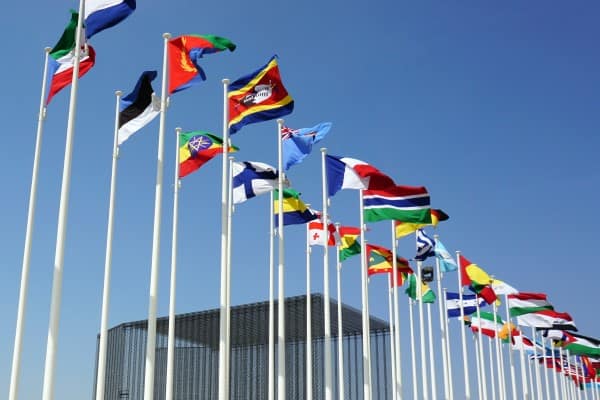This page contains affiliate links. This means if you a follow a link and make a purchase, at no additional cost to you, Humanitarian Careers will receive a commission. Thank you for supporting the site.
The United Nations is the largest and most important international organisation in the world. With 193 member states, almost every country in the world is part of the UN. But what is the United Nations really? Is it a type of alliance between countries? But, with so many states as members, many of which are sworn enemies, could the UN really be considered as an alliance?
The United Nations is technically an alliance, as it is made up of many nations that all signed a treaty – the UN Charter. However, the UN is not an alliance like many others, as nations do not always work together and often do not have the same aims.
…but that’s just an overview.
Why The UN Could Be Considered An Alliance
The United Nations would not formally categorise itself an alliance. The UN describes itself as an intergovernmental organisation. However, there are actually many aspects of the United Nations that do align with being an alliance. The three main ones are:
- There are treaties that bind UN member states
- The UN Is an association formed for mutual benefit
- UN countries work together on many issues
Let’s take a quick look at each of these…
There Are Treaties That Bind UN Member States
A first reason why the United Nations could be considered an alliance is because member states of the UN have signed and (almost all) ratified a treaty that binds them together.
All countries that become UN members sign the UN Charter. The UN Charter is not only the founding document that established the UN, but it is also a treaty to which member states sign-up to. By signing the UN Charter, member states agree to uphold international law, strive for global peace, and aim to produce good living conditions for their citizens.
The fact that all member state of the UN are signatures of a formal treaty – the UN Charter, is one reason why the United Nations could be seen as an alliance.
The UN Is An Association Formed For Mutual Benefit
A second reason why the UN is an alliance is because the organisation was formed for the mutual benefit of its members.
The UN works on a huge range of projects, from mine clearance and assisting refugees, to development aid and climate change. UN projects are massively beneficial to every member state. Although some member states, mostly the poorer countries of the world, could be said to benefit more, in actual fact all countries benefit from tackling poverty, climate breakdown, counterterrorism and improved global diplomacy.
As an organisation, the UN operates for the benefits of its member states. This therefore could be a reason why it is seen as an alliance.
UN Countries Work Together On Many Issues
A third reason why it could be said that the UN is an alliance is because member states, at least on paper, if not in actuality, work towards a few single shared aims.
The United Nations works to improve coordination and cooperation between nations, with the aim of improving global peace and security and reducing poverty worldwide. All nations that that become UN member states formally agree to work towards these aims.
Although many would argue that not all member states actually work towards the stated aims of the United Nations, the fact that officially they do does mean that the UN could be categorised as an alliance.
United Nations Online Courses
If you want to learn more about the United Nations, including what type of organisation it is, we highly recommend the online course Global Diplomacy: The United Nations in the World offered by SOAS in London. We think it provides one of the best overviews of the UN and its role in the current global order. SOAS is also one of the top universities in the world for international relations and courses related to the UN. Click the link for more information.
The Sustainable Development Goals (SDG) underpin all of the UN’s work. In order to fully understand the United Nations, you need a basic understanding of the SDG. We think the online short course The Sustainable Development Goals – A Global, Transdisciplinary Vision For The Future offered by the University of Copenhagen is one of the best introductions to the SDG. Follow the link to the course’s page.
The University of Leiden in the Netherlands offers an online short course on The Changing Global Order. It includes a specific look at how shifting international power dynamics are affecting the current global system and the United Nations. For those wanting to understand the UN, this online course is a must. We’ve linked to the course’s page.
Why The United Nations Is Not Seen As An Alliance
As we said, if you asked someone at the UN if the organisation is an alliance, they would almost certainly say no. This is actually for good reason. Although, as we have discussed, there are some key factors about the United Nations that mean that it could be described as an alliance, there are actually other factors that mean alliance really isn’t the right term to describe the UN.
- UN member states do not always work together
- UN countries do not all have the same aims
- Not all UN member states have signed every UN treaty
Now let’s go over each of these in-turn…
UN Member States Do Not Always Work Together
A first reason why the UN is actually not an alliance is because the member states of the organisation do not always work together.
A major criticism of the United Nations is that nations are often at odds with each other. Major world crises remain unresolved because countries cannot agree on what should be done. In other instances, UN member states may deliberately frustrate efforts to resolve an issue because they do not see it as being in their own interest.
It’s clear the UN often fails to get nations to work coherently together. This is a major reason why it is not an alliance.
UN Countries Do Not All Have The Same Aims
A key factor of alliances is that the participating parties are all working towards the same aim. This isn’t necessarily true for the United Nations and so is another reason why it is not an alliance.
Although officially all member states of the United Nations are working towards global peace and security, in fact they are all working towards forwarding their own strategic, economic, and political interests. Some may be more altruistic than others, but all nations really look out for themselves first.
The fact that the nations of the UN do not collectively work towards it’s stated aims as their paramount objective, shows it is not an alliance.
Not All UN Member States Have Signed Every UN Treaty
A third reason why the United Nations is not an alliance is because not all countries have officially signed-up to all aspects of the organisation.
International alliances are treaty bound. This means nations sign treaties that formally agree on what they will work towards. However, the United Nations has member states that have not signed treaties. For example, the US has never ratified key UN treaties including the UN Convention on the Rights of the Child, the UN Convention on Cluster Munitions and UN Convention of the Rights of Persons with Disabilities. There are many other UN member states have not signed or ratified UN treaties as well.
For the UN to be an alliance, it’s members would need to be formally bound by a treat. As not all UN treaties have been signed by all member states, this is one indication that the UN is not an alliance.
Is The United Nations A Coalition
Ok, so we’ve gone over why the UN could be an alliance, and why it couldn’t. However, as well as those calling the UN an alliance, there are others who describe the organisation as a coalition of nations. Is this correct? Is the UN actually a coalition?
The United Nations is not a coalition. The definition of a coalition is a temporary arrangement between parties to achieve a united aim. The UN is not a coalition because countries are permanent members, and they do not directly work towards achieving a single shared goal.
The term ‘coalition’ is most commonly used to describe political parties that agree to work together for a set period of time so that they may both achieve some of their political aims. People also talk about military coalitions – where countries may not be formally allied but work together to achieve a set military objective.
A key aspect of a coalition is that it is not a permanent agreement between two entities, but a temporary one. The United Nations is not a coalition because all UN states sign the UN Charter and become members permanently. There is no time limit on countries being part of the United Nations and no country has ever completely left the UN.
Another aspect of a coalition is that it’s when two or more parties work together to achieve one united aim. This also doesn’t really apply to the UN. Although countries technically join the United Nations to work towards global peace and security, in fact members join for many different reasons. All UN member states have their own agendas and objectives. Countries in the United Nations are not working closely together for one outcome, and therefore the UN cannot be described as a coalition.
If you want to learn more about the United Nations, and whether it is an alliance, explore our list of the top UN online courses here.





